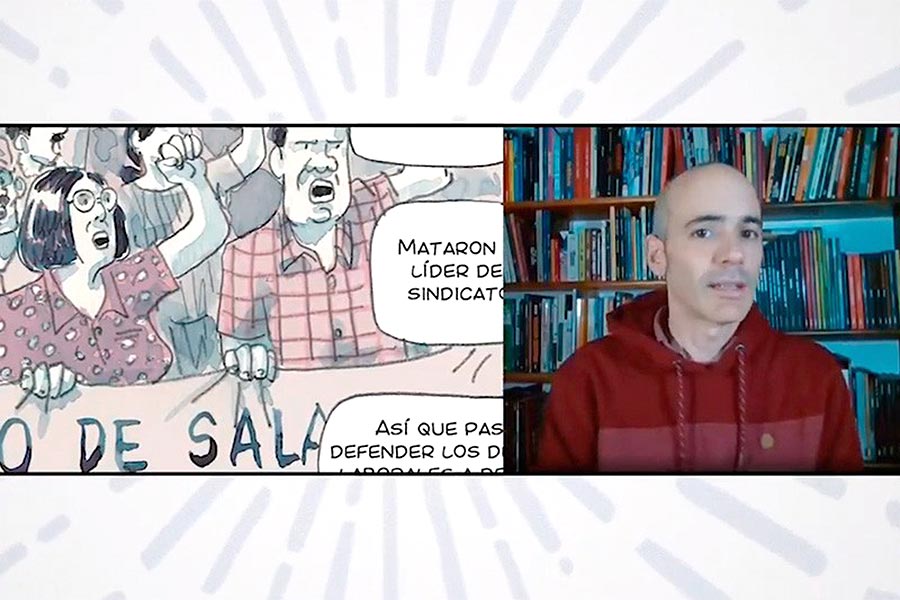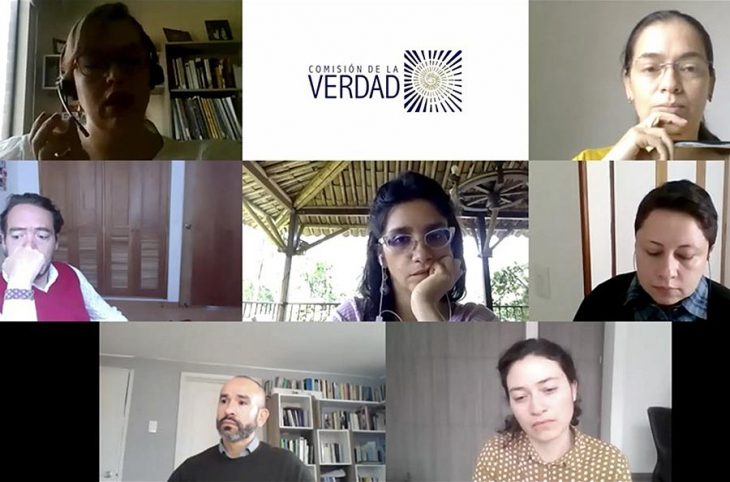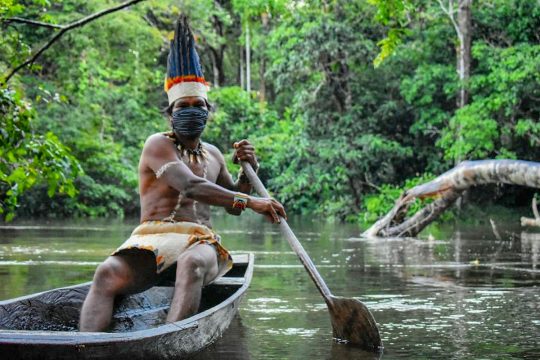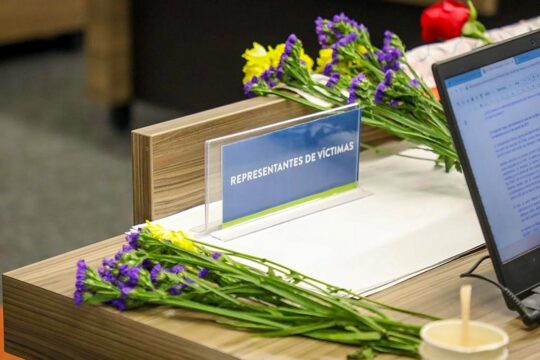On December 12th, the former leaders of two of Colombia’s most notorious illegal armed groups publicly asked for forgiveness over atrocities committed against 1,1 million Afro-Colombians during the country’s 52-year long armed conflict.
“Bojayá will always be on our backs, despite the generosity afforded by victims to us,” said Rodrigo Londoño, referring to the 2002 massacre perpetrated by the left-wing Revolutionary Armed Forces of Colombia (FARC) guerrilla he led for a decade until the 2016 peace deal with the Colombian government. “You can count on me to help clarify what happened and to each of those affected, I ask for forgiveness from my heart”, said former right-wing paramilitary boss Salvatore Mancuso from his US prison, speaking of a mass displacement in Mampuján two years before. Alongside them, a former mayor admitted to abetting the paramilitaries and a banana grower owned up to his role in another massacre.
In the preceding two days, a peasant leader had discussed how to ensure the end of violence in the Sumapaz mountainous area outside Bogota with a former FARC rebel who used to operate there, a university legal clinic presented a report on how war affected persons with disabilities and a dozen of active and retired military shared their stories of pain.
With one caveat: all of these happened on Facebook, Youtube and Zoom, with individual rectangular screens replacing podium speeches and a mise-en-scène that draws more from TV formats than public hearings.
A sudden change of plans
This kaleidoscope of events underscores how Colombia’s Truth Reconciliation Commission (TRC) reinvented itself over 2020.
As the Covid-19 pandemic hit the country in March, the commission was just beginning the second of a three-year mandate. Its plan of spending most of the year on the field, speaking with communities, holding hundreds of local events and gathering information for its final report was suddenly thrown into disarray, as Colombia’s government banned large gatherings and even outdoor activities for five months, in what became one of the lengthiest lockdowns in the world.
Covid heavily disrupted the work of the entire transitional justice system born out of the peace accord. As Justice Info has told, the pandemic hindered the Special Jurisdiction for Peace or JEP, its judicial arm, from holding large public hearings and meeting with many victims. It also delayed the beginning of an ambitious redress programme for indigenous victims in the Amazon and has rendered thousands of victims more vulnerable, amid the worst economic crisis in 20 years and a decline in security conditions in many regions.
But its impact on the TRC, the extrajudicial arm of the system tasked with promoting truth-telling and fostering reconciliation, was especially acute. While the JEP has a 15-year mandate, the Unit to Search for Persons Deemed Missing enjoys no fixed timeframe and the recent approval of a ten-year extension to the country’s 2011 victims’ bill means that reparations will continue, the TRC is due to wrap up its activities in November 2021. The infectious disease even struck the TRC directly, when one of its eleven commissioners – respected Afro-Colombian community organizer Ángela Salazar – died in August.
The TRC’s digital babies
Since the middle of 2020, the TRC has been creating and launching one new initiative after another on TV, radio and online, in a bid to further its double goals of producing an in-depth report and enabling collective catharsis over mass atrocities in Colombia.
“Truth out loud”, a 25-minute podcast series in which well-known journalist Claudia Morales interviews individual victims on their experiences and expectations, began airing every Saturday on national radio. TRC commissioner and former museum director Lucía González began holding fortnightly conversations on art and trauma – dubbed “Naming the unnameable” – with famous artists, writers and filmmakers. Less highbrow and more pop culture, the TV series “Before the mirror” has brought together actors, singers and social media influencers to discuss reconciliation in a down-to-earth tone. Another program, “Let’s discuss truth”, focuses on local discussions around reconciliation and airs weekly on regional TV channels. “Voices of truth”, a radio program sharing victims’ stories, became a substitute for the two dozen local ‘houses of truth’ that had to be shuttered due to the public health crisis.
Its events have combined different truth-seeking strategies, including giving victims a prominent podium to share their stories, inviting perpetrators to acknowledge their responsibility and unearthing missing truths. Given how easy it is to get lost amid the flurry of activities, journalists receive a three-page pdf agenda at the beginning of each week on their phones, listing every upcoming event, whether public or private.
The TRC also combined production strategies. Some were made in-house, like comics and short animations that illustrated lesser known aspects of victims’ experiences, such as how Afro-Colombian women resorted to riverside laundry rituals to cope. Others were held in partnership with large media organisations, including a contract with Semana – the country’s largest news magazine – to air ‘listening spaces’ with key actors like the military or politicians.
“I think we managed to make a leap in reaching new audiences and people, mainly by switching to other channels of communication. We changed our more traditional format of holding large events for partnerships with mass media, something we couldn’t have done without the international community’s financial support and flexibility”, says María Prada, the TRC’s head of cooperation and partnerships.
In the long run, the pandemic helped the TRC sort out a number of internal differences over what its priorities should be and a sense of chaos in its event scheduling, both of which had marred its work during its first year of life, according to two other persons working there.

Reaching out to sceptical voices
The TRC’s second year also saw it make inroads with a number of sectors of Colombian society that have been sceptical of its work, including religious organisations, political parties and especially the military (although not, as Justice Info has told, with business leaders).
After back and forth discussions last year over openly debating many issues related to the armed conflict with the TRC both privately and publicly, this year saw the military – and to a lesser extent the police – submit over 40 reports and feature in dozens of public events. Many of these have been highly emotional, including one – the first after Colombia went out of its lockdown – with officials who were landmine victims and another one with relatives of police officers who were victims of forced disappearance.
This breakthrough doesn’t mean things have always gone smoothly. In July, during the presentation of a report on the positive transformations within the military, TRC president Francisco de Roux goaded them to tackle difficult subjects, like past connivance with right-wing paramilitary groups. He did so by using a well chosen simile from the institution he himself hails from: the Catholic Church.
“I invite you to follow the example of Pope Francis when, facing priests’ abuse of children, he acknowledged this wasn’t just about rotten apples, but an illness in the Church’s body,” the Jesuit priest told the Army’s commander-in-chief, general Eduardo Zapateiro. “No institution can defend itself from serious moral misconduct among its men and claim that it isn’t responsible because its laws forbid it. (…) I want my country's Army to show the same greatness the Church had.”
The Army hears the message
A few months later, the military presented a report on the subject. Even though it remains confidential, as all reports received by the TRC, it shows they are aware – unlike the business sector – that by contributing to its work, they may help shape its narrative about Colombia’s recent past and provide a broader picture of truths that are emerging in the JEP on crimes such as extrajudicial executions.
“Despite setbacks under the new wing and pressure from veterans’ organisations, the military truly feel they have to be there and feel the urgency of recovering dialogue with civil society,” says sociologist Eduardo Pizarro, who led the National Commission for Reparation and Reconciliation after the 2005 demobilisation of the paramilitaries, which gave way to the country’s Historical Memory Group, and recently wrote a history of the Army.
“The Armed Forces are genuinely grateful with the TRC for its openness and willingness to listen, which has even allowed the discussion of tough issues like the national security doctrine or the ‘internal enemy’ theory. This doesn’t mean, however, that there isn’t still some level of mistrust regarding how much their input will be taken into account in the final report”, says Jean Carlo Mejía, a military defence lawyer who has worked to bridge that gap between both.
Getting there was the result of a year-long process, which included private conversations facilitated by the TRC with peers who played an active role in the transitions in Chile, Nigeria and Gambia. “Even if only 5 percent of members committed crimes, as you say, are you going to stop participating because of this?” retired general Javier Urbina, a member of Chile’s TRC, told a group of generals. “If you choose not to go to the dinner party, you’ll be on the menu”, Catalonian peace researcher Vicenç Fisas told them in another previous meeting that, according to a source who has worked with them, had an impact on them.
Can online truth-seeking become massive?
At least 881,000 persons had watched any of the 216 events the TRC had live-streamed until early December, with its reach on Twitter and Facebook doubling from last year, according to internal statistics shared with Justice Info.
Massive reach is however difficult. With 82,000 followers on Facebook, 50,000 on Twitter, 30,000 on Instagram and 12,700 subscribers on Youtube, social media is still quite limited in a country of 48 million where only two thirds have mobile internet. Even though part of the TRC’s work has also appeared on TV and radio, its major challenge continues to be how to reach out to ordinary Colombians, many of whom have not been directly affected by the armed conflict or live in areas where security conditions improved over a decade ago.
So many people don’t normally keep tabs on these issues and right now rank employment or the economy are higher up on their list of concerns than security. This year, in the wake of the pandemic, Colombians are thinking about survival.”
As Jean Carlo Mejía points out, “so many people don’t normally keep tabs on these issues and right now rank employment or the economy are higher up on their list of concerns than security. This year, in the wake of the pandemic, Colombians are thinking about survival.”
Given this reality, a number of prominent academics and leaders are calling on the TRC to continue seeking ways to make its work even more massive, for example suggesting making the final report a documentary instead of an encyclopaedic text – especially since violence persists, with one other guerrilla and numerous organised crime groups still operating. Their reasoning is that some of the most poignant moments the TRC has fostered haven’t had the public significance they warranted. When 30 former members of seven different armed groups, including FARC and the paramilitaries, worked over eight months on an agreement on how to ensure the end of political violence, few noticed. “I found all of it extraordinary: they went from not shaking hands or looking each other in the eyes to slowly finding common ground. And yet it was fifth-page news,” says Eduardo Pizarro.
Events this year have seen more coverage, but still haven’t become mainstream. When Salvatore Mancuso owned up to the 2001 murder of Embera indigenous leader Kimy Pernía and apologised to his daughter Martha Cecilia Domicó in what was a very momentous acknowledgment for indigenous peoples, it wasn’t front-page news either.
“We must build a plural account of the past and a shared one of the future, because it’s possible to have differing visions of what happened – and that is not negative – but crucial to choose common values going forward,” adds Pizarro, whose recent article proposing a decalogue of possible points of agreement – against the use of private armies, kidnapping, sexual violence, child soldiers or going up in arms as a path towards power – was widely shared within the TRC. “By emphasising the desired future, it disqualifies groups such as the ELN guerrilla and FARC dissidences, sends a very strong message to the military that they cannot commit excesses against citizens and, in general, can help turn the page,” he adds.
Will three years be enough?
Additionally, the TRC still has to work on some of the more ground-breaking tasks in its mandate, including documenting the impact the armed conflict had on the political process and the environment, or the positive transformations undertaken by state institutions during it.
Amid the pandemic, another question has arisen: could the TRC’s timeframe be extended beyond November 2021 to allow it more time to work and reach more Colombians?
The problem is that what might seem like a good alternative on paper, is in fact a complicated political gambit. Any extension of its mandate requires an amendment in Congress, given that it was created by a presidential decree-law and current President Iván Duque refused to attend the TRC’s inauguration in 2019. His party, the Democratic Centre, does not command a majority in Congress and has been roundly defeated in its attempts to modify the JEP, but over the past year the government has strengthened its ties to other parties and could oppose any bid to extend the mandate of an institution they often criticise publicly in a pre-election year.
Passage of such an amendment would anyhow take at least six months, given the unlikeliness of a Government-sanctioned urgency that could shorten the legislative timeframe to two months. This means that in a country that has not yet fully tuned in to what it has been doing, the TRC will probably revisit many of the lessons it has learned during a pandemic year and step up its outreach during 2021.








